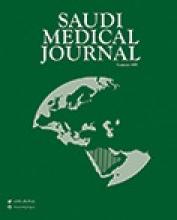Abstract
OBJECTIVE: To determine the rate of reporting communicable diseases in Jeddah region, and to compare the recording system between the governmental and private sector.
METHODS: This is a review of records study, in which the reports of communicable diseases from all hospitals and health centers (with or without cases) were studied, during the period of study; 1st to 25th international weeks 1999, and the reporting rate was calculated. A simple random sample was collected from these international weeks to evaluate the quality of recorded information.
RESULTS: The reporting rate was 74%. Private hospitals have the highest rate in reporting (87%) and polyclinics have the least (67%). The recording rate was above 90% for administrative data. Personal data was complete except for patient name (76.5%), address (20%), and occupation (73%). The most prominent defect in the disease data was found to be in recording the mode of infection (13%), followed by previous vaccination (29%), date of symptoms (89%), and date of diagnosis (98%). Mode of infection was recorded in (40.5%) of cases by primary health care centers, but in polyclinics in only 1% of cases. Previous vaccination was recorded better by governmental sectors; (29%) by governmental hospital and (49%) by primary health care centers while in the private sectors the rate was (21%) by polyclinic and (25%) by private hospital. Date of symptoms was recorded in 90% of cases in all sectors except in governmental hospitals where it was only (50%). Date of diagnosis was recorded in more than (95%) in all sectors. The results show a statistical significant difference between different health sectors in recording data where government hospitals were least in recording doctor's name and in putting an official stamp in the form (p< 0.001); primary health care centers were the best in recording patient name and occupation (p< 0.001); polyclinics were least in recording mode of infection and previous vaccination (p< 0.001); for recording date of symptoms private hospitals were the best (p< 0.001).
CONCLUSION: The reporting rate in Jeddah region was 74%, but its usefulness was diminished because of the incomplete, absent or incorrect personal and disease data.
- Copyright: © Saudi Medical Journal
This is an open-access article distributed under the terms of the Creative Commons Attribution-Noncommercial-Share Alike 3.0 Unported, which permits unrestricted use, distribution, and reproduction in any medium, provided the original work is properly cited.






